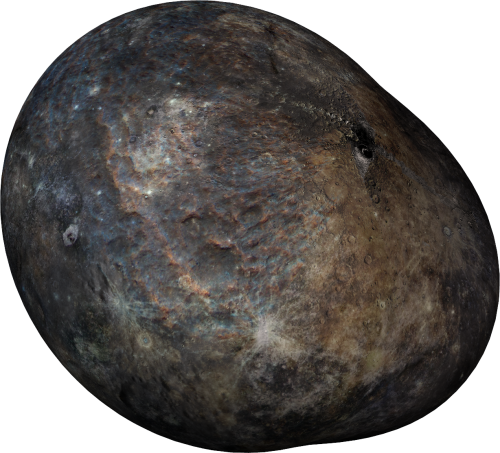
PLANET

CLASS F: NICKEL/IRON
TYPE
Terrestrial
CORE
Molten nickel/iron inner core, solid iron outer core
MANTLE
Silicate rocks
SURFACE
Silicate rocks
ATMOSPHERE
Tenuous; hydrogen, helium, and oxygen
LIFE
None
Class F: Nickel/Iron worlds are small, rocky planets that form in close orbit to a star, where iron-rich material is present in the protoplanetary disk. They are structurally different from other terrestrial planets, as they tend to have very large cores of nickel and iron, and thin mantles composed primarily of silicate rocks. The lack of a mantle means Class F planets are geologically inactive. The surface is barren and rocky, also composed of silicate rocks. Most Class F worlds do not have an atmosphere; close proximity to a star means any atmosphere is blown away by solar winds and radiation. In rare planets where at atmosphere is present, it is tenuous at best. There are exceptions, however, as described below. Many Class F worlds are tidally locked to their parent star; as a result, one side of the planet is constantly scorched with temperatures over 400° C; however, due to the lack of atmosphere, this heat cannot be retained, and the night side of the planet is a frigid -170° C.
CLASS F1: PROTOPLANET

A protoplanet is a large planetary embryo developing within the protoplanetary disc of a young star system. Such bodies will have undergone some internal melting to produce a differentiated core. Over the span of many millions of years, protoplanets, will gain more matter through collisions with nearby bodies, and eventually attain a spherical shape.
In the case of a Class F protoplanet, this embryo would be rich in iron and nickel.
CLASS F2: BARREN
The typical representation of a Class F world is the barren one. Tiny, geologically inactive worlds, baked on one side, frozen on the other, and completely dead. Almost all Class F worlds fall into this category.

CLASS F3: HOTHOUSE

In very rare instances, Class F planets develop far enough from a star to maintain an atmosphere. These cloud-shrouded worlds would be blazing hot and have an atmosphere loaded with carbon monoxide. Rather than water, lakes of iron carbonyl and other exotic volatiles may pool on the surface.
SUBCLASS FC: CHTHONIAN
A Chthonian planet is the metallic core of a gas giant that has spiraled inward from the cold zone of a star system and has been stripped of its gaseous components.
SUBCLASS FD: DWARF
Any Class F world that does not meet the minimum size requirements of a planet is considered a dwarf.
SUBCLASS FG: GIANT
A planet that exceeds the standard size of a Class F world is considered a giant.
SUBCLASS FM: MOON
Any object that would otherwise be considered a Class F world, but is a satellite orbiting another body is considered a moon.
SUBCLASS FR: ROGUE
A planet that has been ejected from its star system and is adrift in interstellar space.
SUBCLASS FX: IRRADIATED
A planet that is heavily irradiated by its parent star.



